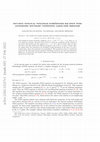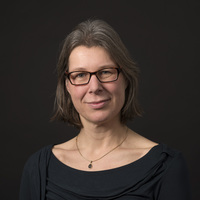Papers by anne Boutet de Monvel
Letters in Mathematical Physics, Feb 22, 2017
We explore a new connection between Seiberg-Witten theory and quantum statistical systems by rela... more We explore a new connection between Seiberg-Witten theory and quantum statistical systems by relating the dual partition function of SU (2) Super Yang-Mills theory in a self-dual Ω-background to the spectral determinant of an ideal Fermi gas. We show that the spectrum of this gas is encoded in the zeroes of the Painlevé III 3 τ function. In addition we find that the Nekrasov partition function on this background can be expressed as an O(2) matrix model. Our construction arises as a four-dimensional limit of a recently proposed conjecture relating topological strings and spectral theory. In this limit, we provide a mathematical proof of the conjecture for the local P 1 × P 1 geometry.

arXiv (Cornell University), Jun 1, 2020
In a recent paper, we presented scenarios of long-time asymptotics for a solution of the focusing... more In a recent paper, we presented scenarios of long-time asymptotics for a solution of the focusing nonlinear Schrödinger equation whose initial data approach two different plane waves A j e iφ j e -2iB j x , j = 1, 2 at minus and plus infinity. In the shock case B 1 < B 2 some scenarios include sectors of genus 3, that is sectors ξ 1 < ξ < ξ 2 , ξ := x t where the leading term of the asymptotics is expressed in terms of hyperelliptic functions attached to a Riemann surface M (ξ) of genus 3. The long-time asymptotic analysis in such a sector is performed in another recent paper. The present paper deals with the asymptotic analysis in a transition zone between two genus 3 sectors ξ 1 < ξ < ξ 0 and ξ 0 < ξ < ξ 2 . The leading term is expressed in terms of elliptic functions attached to a Riemann surface M of genus 1. A central step in the derivation is the construction of a local parametrix in a neighborhood of two merging branch points. We construct this parametrix by solving a model problem which is similar to the Riemann-Hilbert problem associated with the Painlevé IV equation.
St. Petersburg mathematical journal, Apr 12, 2024
We prove that the spectrum of the two-photon quantum Rabi Hamiltonian consists of two eigenvalue ... more We prove that the spectrum of the two-photon quantum Rabi Hamiltonian consists of two eigenvalue sequences (E + m) ∞ m=0 , (E − m) ∞ m=0 satisfying a three-term asymptotic formula with the remainder estimate O(m −1 ln m) when m tends to infinity. By analogy to the one-photon quantum Rabi model, the leading three terms of this asymptotic formula, describe a generalized rotating-wave approximation for large eigenvalues of the two-photon quantum Rabi model.
Comptes Rendus Mathematique, Dec 20, 2023
Asymptotic formula for large eigenvalues of the two-photon quantum Rabi model

Springer eBooks, 2022
We consider the focusing integrable nonlocal nonlinear Schrödinger equation iqt(x, t) + qxx(x, t)... more We consider the focusing integrable nonlocal nonlinear Schrödinger equation iqt(x, t) + qxx(x, t) + 2q 2 (x, t)q(−x, t) = 0 with asymmetric nonzero boundary conditions: q(x, t) → ±Ae −2iA 2 t as x → ±∞, where A > 0 is an arbitrary constant. The goal of this work is to study the asymptotics of the solution of the initial value problem for this equation as t → +∞. For a class of initial values we show that there exist three qualitatively different asymptotic zones in the (x, t) plane. Namely, there are regions where the parameters are modulated (being dependent on the ratio x/t) and a central region, where the parameters are unmodulated. This asymptotic picture is reminiscent of that for the defocusing classical nonlinear Schrödinger equation, but with some important differences. In particular, the absolute value of the solution in all three regions depends on details of the initial data.
This chapter deals with strongly continuous n-parameter groups W of bounded operators in a Banach... more This chapter deals with strongly continuous n-parameter groups W of bounded operators in a Banach space F. The principal topics are certain scales of Banach spaces and the functional calculus that can be associated to such groups.
The purpose of this chapter is to develop a framework for the description and study of hamiltonia... more The purpose of this chapter is to develop a framework for the description and study of hamiltonians having a many-channel structure. The term “many-channel” is used here in a rather vague sense: we are thinking of systems consisting of a (large, but finite) number of components which could interact in a complicated way but could also behave independently (i.e. the interaction between some components could be turned off). So, to the “total hamiltonian” H one should be able to associate a collection of “sub-hamiltonians” H a which, in some sense, should be simpler than H, and then one should construct the spectral and scattering theory of H in terms of the family {H a}.

Let H be a self-adjoint operator in a Hubert space \(H,R(z) = {(H - z)^{ - 1}}\) its resolvent an... more Let H be a self-adjoint operator in a Hubert space \(H,R(z) = {(H - z)^{ - 1}}\) its resolvent and λ a real number in the spectrum of H. \(Since\left\| {R(\lambda + i\mu } \right\| = {\left| \mu \right|^{ - 1}},R(\lambda + i\mu )\) cannot have limits in B(H) as μ → ±0. However, for certain vectors f ∈ H, the function \(F(z) = \left\langle {f,R(z)f} \right\rangle \), which is defined and holomorphic for z outside the spectrum of H, could have a limit as z converges to λ from the upper or lower half-plane (these two limits will be different in general). If this happens for sufficiently many f, one can infer results on the spectral properties of H which are useful for example in scattering theory. This will be elaborated in Section 7.1. The remainder of the chapter is devoted to a detailed description of a method, called the “conjugate operator method”, for proving the existence of such limits.
In this chapter we present some results of the theory of interpolation in Banach spaces. We limit... more In this chapter we present some results of the theory of interpolation in Banach spaces. We limit our considerations to those parts of the theory that will be useful further on in this text. In particular we develop the interpolation theory for a pair of Banach spaces E, F only under the assumption that E is continuously embedded into F. The case of an arbitrary compatible couple does not demand any new idea; for a detailed treatment of the general theory, see [BB], [BK], [BL], [BS], [KPS], [Tr]. The results described below are essentially due to N. Aronszjan, E. Gagliardo, J.-L. Lions and J. Peetre
Journal of Physics A, Dec 19, 2014
We present an inverse scattering transform approach for the equation utxx − 3ux + 3uxuxx + uuxxx ... more We present an inverse scattering transform approach for the equation utxx − 3ux + 3uxuxx + uuxxx = 0. This equation can be viewed as the short wave model for the Degasperis-Procesi equation or the differentiated Ostrovsky-Vakhnenko equation. The approach is based on an associated Riemann-Hilbert problem, which allows us to give a representation for the classical (smooth) solution, to get the principal term of its long time asymptotics, and also to describe loop soliton solutions.
Modern Birkhäuser classics, 1996
Koyu, Ie religieux, dit: seule une personne de compnihension reduite desire arranger les choses e... more Koyu, Ie religieux, dit: seule une personne de compnihension reduite desire arranger les choses en series completes. C'est l'incompletude qui est desirable. En tout, mauvaise est la regula rite. Dans les palais d'autrefois, on laissait toujours un bdtiment inacheve, obhgatoirement.

Birkhäuser Basel eBooks, 1996
This chapter is devoted to some aspects of distribution theory. In Section 1.1 we define various ... more This chapter is devoted to some aspects of distribution theory. In Section 1.1 we define various spaces of smooth functions as well as some differential operators; we insist on an invariant definition of these objects, since this will be important in the study of N-body Hamiltonians. Various definitions and facts from distribution theory are reviewed in Section 1.2. The reader should be familiar with the contents of these two sections because we fix notations and terminology which are in some cases not quite standard. Sections 1.3 and 1.4 are more technical and may be skipped temporarily. We prove results relating local regularity properties of a distribution with the behaviour at infinity of its Fourier transform. We also establish an identity due to A. P. Calderon giving a representation of a distribution in terms of its derivatives of a fixed order plus a regular term. Finally, we use this representation in order to prove several facts that will be needed in later chapters.
arXiv (Cornell University), Aug 7, 2016
We develop a Riemann-Hilbert approach to the inverse scattering transform method for the short pu... more We develop a Riemann-Hilbert approach to the inverse scattering transform method for the short pulse (SP) equation uxt = u + 1 6 (u 3)xx with zero boundary conditions (as |x| → ∞). This approach is directly applied to a Lax pair for the SP equation. It allows us to give a parametric representation of the solution to the Cauchy problem. This representation is then used for studying the long-time behavior of the solution as well as for retrieving the soliton solutions. Finally, the analysis of the long-time behavior allows us to formulate, in spectral terms, a sufficient condition for the wave breaking.
Analysis and Mathematical Physics, May 26, 2013
The rational quantum algebraically integrable systems are non-trivial generalizations of Laplacia... more The rational quantum algebraically integrable systems are non-trivial generalizations of Laplacian operators to the case of elliptic operators with variable coefficients. We study corresponding extensions of Laplacian growth connected with algebraically integrable systems, describing viscous free-boundary flows in non-homogenous media. We introduce a class of planar flows related with application of Adler-Moser polynomials and construct solutions for higher-dimensional cases, where the conformal mapping technique is unavailable.
American Mathematical Society translations, Sep 26, 2014
Journal of Mathematical Physics, 2000
We study the inverse problem for a dispersive stratified chiral slab. The problem is treated as a... more We study the inverse problem for a dispersive stratified chiral slab. The problem is treated as an analytic factorization problem in the complex plane of frequencies. Emphasis is made on the reconstruction of the spatial dependence of the medium parameters, whereas the frequency dependence is supposed to be a single-resonance Lorentz model. It is shown that, under the normal incidence of exciting plane waves, the scattering data as functions of alternating frequency allows reconstructing three independent combinations of four space-varying medium parameters. If one parameter is known, all other parameters are uniquely reconstructed.
Evolution equations, Feshbach resonances …, 1995
Page 1. THE CONJUGATE OPERATOR METHOD: APPLICATION TO DIRAC OPERATORS AND TO STRATIFIED MEDIA By ... more Page 1. THE CONJUGATE OPERATOR METHOD: APPLICATION TO DIRAC OPERATORS AND TO STRATIFIED MEDIA By Anne Boutet de Monvel and Radu Purice IMA Preprint Series # 1341 October 1995 INSTITUTE FOR ...
SIAM Journal on Mathematical Analysis, 2010
We consider the initial value problem for the Camassa–Holm equation on the line with decaying ini... more We consider the initial value problem for the Camassa–Holm equation on the line with decaying initial data. We apply the nonlinear steepest descent approach to compute the long-time asymptotics of the solution in two transition regions. In both regions the asymptotics is expressed in terms of second Painleve transcendents.











Uploads
Papers by anne Boutet de Monvel